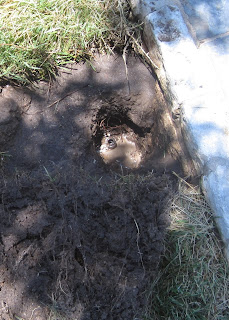While doing the maintenance for the irrigation system, and computing the amount of water that each zone takes, we figured we should switch out the heads for Zone 4 and Zone 6 (which are the Rain Bird 1800 pop-up spray heads) with the rotary heads that we used in the front, in Zone 10. The rotary heads are supposed to be much more efficient than the standard pop-up spray heads. I can swap out the heads, but all heads in a given zone should be the same. So upgrading Zone 4 means replacing all 15 heads.
I ordered the heads thru Amazon, for both Zone 4 and Zone 6. Twenty-three Rain Bird 8SAPROPR Pressure Regulating (PRS) High-Efficiency Pro Rotary Sprinkler, Hand Adjustable 45° - 270° Pattern, and Seven 8SAFPROPR 360 degree Full Pattern. $499.28.
To upgrade the zone, we first needed to find all the heads. We ordered the right number of heads based on our plan for the zone. We turned on the zone, and used left-over flags from gas and electrical line markings to mark where the heads were. Mostly they popped-up, but a couple were held down by grass that had grown over them and were harder to find.
Then we dug out around each head, so that we could easily find it, and work with it.
Some of the heads were significantly down in the dirt and took some digging to find. We would need to raise those up to ground level for either the new heads or the old ones, as we need to add to the riser underneath the head.
Some five heads were buried like this and needed to be raised up between 3 and 5 inches. We had to go to both Lowe's ($8.44) and Home Depot ($$6.19) to get parts to replace the existing risers with the right heights
In addition, before we started doing anything else, we figured we should check for any leaks in this zone. On each head, in the middle is a little screw, and turning the screw clockwise until it stops closes off the spray from that head. So screwing down all 15 heads should cut off all water for the zone.
Doing that, and then checking the water meter at the street, we see that there is still significant water flow. Going back and looking over each head, we notice that one is wet and getting wetter. Digging down around it shows a break in the riser under that head. So 6 heads need to be dug up and the risers replaced -- five for height and one to fix a leak.
When those 6 heads are dug out, the risers repaired and replaced, we went ahead and switched out the heads with the new heads at the same time.
For the other 9 heads, we noted that the plastic exterior for the heads is the same for the Rain Bird 1800 heads and the new Rotary heads. So we could simply unscrew the old 1800 heads from the plastic exterior
remove the shaft and spring from inside the plastic exterior, and then unscrew the head from the new rotary head and put it in the 1800 plastic exterior, still in the ground.
Digging up a head, down to the riser, and replacing the entire thing takes about a half an hour (or more). Switching out the insides takes just seconds.
In fact, we removed all the old heads, and then turned on zone 4, so we had water flowing from the old plastic exteriors -- flushing out anything that was in the lines. While it was flowing, we were able to go around and put the new heads into the old exterior plastic and screw them in place. All until the last one. The force of the water for the last one was too much. At that point, we turned off the water, put in the last one, and then turned the water back on.
Because once the heads were all in place, they needed to be adjusted. Almost all of them were adjustable (from 45 degrees to 270 degrees), so we had to go around to each and adjust them to the right angle and start position. Mostly they were either 90 degrees (for corners) or 180 degrees (for running along a side), but we were able to adjust them to fit whatever we needed.
We did have one head that seems to rotate at about 3 times the speed of the others. Most of the heads lazily rotate around, but one spins like mad. I called Rain Bird customer service and they suggest switching out the part on the top that spins with another head, and if that doesn't work, then the whole unit. Apparently you can buy (and replace) just the top spray part. So apparently the fast spinning one is defective (although customer service would not come right out and say that; nor did they offer to replace the defective one with a good one.) We have extra parts until we do Zone 6.
This whole process basically took all day.
Switching out the heads dropped the 5-minute usage for Zone 4 from 105 gallons to 54 gallons.
















